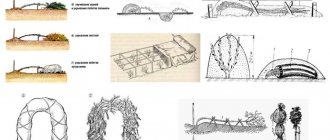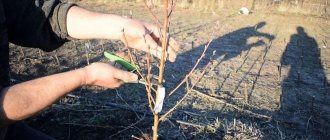Roses are beautiful, but they do not always delight even their adherents. For example, a flower garden or front garden attracts little attention if it is in a neglected, unkempt state. To keep rose bushes in good condition, scheduled pruning is carried out in spring, summer and autumn. You should be especially responsible when it comes to autumn pruning, since it is part of preparing plants for the winter dormant period. There are general recommendations for caring for all types of roses. But in addition to the generally accepted ones, there are individual rules for autumn pruning for each type of rose.
Why do you need to prune roses for the winter?
Not all roses need such preparation for wintering, but if you have a tea rose, Bourbon or Chinese rose, then you cannot do without pruning the shoots. Yellow roses are also sensitive to cold. Of course, a lot depends on the natural conditions of the region where the flowers grow.
Everyone wants roses to bloom abundantly in the warm season, but you cannot get numerous buds without first pruning them for the winter. Unripe shoots under cover often disappear or simply rot. And after pruning, the bush has access to sunlight and air, so winter hardiness increases. The plant retires in time and accumulates strength in the spring.
The rose bush produces new shoots beautifully in the spring.
In place of the cut shoots, new ones will form next year, which will turn the bush into a worthy queen of the garden.
What to do after?
It is recommended to treat the plant after all of the above procedures. The choice of product depends on the climate. There are two options:
- in cold weather (below +5), iron-containing preparations are used;
- at temperatures above +6 - copper-containing substances.
Important! Iron sulfate at warm temperatures can burn the bushes, and copper preparation at low temperatures will be useless.
After all the procedures, all that remains is to wrap the bushes, which will provide favorable conditions during winter “hibernation”.
When to prune roses for winter?
Starting from mid-October, stable, low, negative temperatures are expected. Minus 1-3 degrees as an average night temperature indicates that it is time to start preparing rose bushes for winter. You definitely need to focus on the weather forecast - thaws must be excluded, otherwise all the pruned bushes will immediately produce new shoots, which can then lead to the death of the plant.
Therefore, no matter how much you are in a hurry, roses should be pruned in the fall before covering only at the first stable frost.
The rose has dropped its leaves. What to do if your houseplant drops its leaves?
There are several reasons why this whimsical plant sheds its leaves and dries up:
- Physiological aging is when a flower, at the final stage of its life, begins to shed its leaves and buds.
- Seasonality - when an indoor flower sheds its leaves in the fall so that new ones grow in the spring.
- Violation of the light regime - lack or excess of sunlight.
- A change in weather or a change in the microclimate of the house - a change in air temperature and humidity level in the room, the appearance of a draft or the start of heating devices in the house affect the condition of the rose.
- Violation of the irrigation regime - lack or excess of moisture in the soil.
- Presence of pests – parasites dangerous to flowers, especially spider mites, can destroy a plant in a matter of days.
- Unsuitable soil - a lack or excess of nutrients in the soil leads to the fact that the flower begins to hurt and wither.
- The rose is damaged by pathogenic microflora - the flower begins to rot or black spots appear on it.
If the leaves of a rose begin to fall, it is recommended:
- Carefully examine the flower. If the leaves turn yellow and fall off on one side, this may indicate an excess of sunlight. In such a situation, it is necessary to provide the rose with diffused light.
- Check the soil in the pot. If the pot has cracked, dry soil, you need to start watering it regularly. For irrigation, use pre-settled water at room temperature.
- Remember the last time the soil of the rose was changed. If it was more than a year ago, then it is advisable to urgently start feeding the plant. But you should carefully study the instructions and strictly follow them so as not to overfeed.
- Check leaves and stems. If pests are detected, it is recommended not to delay the start of treatment. In this case, it is necessary: Isolate the rose from other plants.
- Use a sterile blade to trim off all affected areas.
- Treat with parasite repellent according to instructions.
If a rose drops all its leaves in the shortest possible time in spring or summer, this means that:
- The flower is located in a room with very dry air. What to do in a situation if the plant has dropped all its leaves:
- Move it to another room or install a humidifier nearby.
- Water the flower regularly and do not allow the soil to dry out.
- The flower was infected with a dangerous disease. In this situation, the action plan is as follows:
- Trim off all affected areas of the flower and remaining buds with a sterile blade.
- Treat the plant with special means.
A rose that has dropped all its leaves will take a long time to recover, so it is recommended to be patient and wait, while observing the light and watering regime.
General rules for pruning roses
The stems are cut either with sharp pruning shears or with a special hacksaw next to the unsprouted bud. Usually, 0.5 cm is left from the bud to the cut. The shoot is cut at a slight angle to drain water and prevent infection. To prevent the shoots from crossing in the future, cut off the shoots on the outer bud.
Pruning is an important condition for preserving the plant.
For the procedure, choose a sunny day and shorten the roses to the white core of the stems. It is good if each remaining shoot is treated with garden varnish at the cut.
Caring for bushes after pruning
How to mulch roses - which mulch is better
Autumn work on caring for rose bushes is not limited to pruning. These include:
- applying phosphorus-potassium fertilizers, which help the shoots to ripen;
- removing faded flowers;
- pinching young shoots;
- burning or adding to compost the green mass left after cutting plants;
- processing of cuts with garden varnish or a specialized paste;
- removing leaves before constructing a shelter to prevent the appearance of rot.
Rose is one of the most beautiful garden plants. To help it adequately withstand the tests of frost in winter, it is important to properly cut off its shoots, as well as carry out other autumn care measures.
Tools and materials for pruning roses
Ideally, it is better to disinfect a sharp pruner in any convenient way, both before the procedure and after each bush. By acting in such a long way, you can be sure that the transmission of the disease from bush to bush is excluded.
The secateurs are very convenient to work with
A hacksaw copes with thick shoots
What to prepare in advance?
To speed up work and increase productivity, you need to prepare. Suitable tools and clothing will make the job easier.
Thick, durable gloves, thick garden trousers, and a long-sleeved jacket will provide good protection for your hands and feet from thorns.
When pruning roses, you must wear protective equipment and use special gardening tools.
A sharp pruner or scissors is suitable for this work.
Important! Transferring an infection from one branch to another is a common problem. Experienced gardeners recommend disinfecting tools with a solution of potassium permanganate or phytosporin. You just need to periodically dip the pruning shears in the liquid and continue working.
The cut areas are usually treated with garden pitch, coal or putty. This way the plant will not be afraid of fungus, insects and pests.
Types of rose pruning depending on variety
To avoid mistakes, first tear off all the foliage and remove small thin shoots, especially if they stick out from the ground. The second step is the removal of immature, old and dry shoots. Then, the bush is carefully examined and the appropriate pruning method is determined.
Pruned bush
Short trim
This is pruning of last resort because it negatively affects frost resistance. The shoot is cut down to almost 3-4 buds at the very base, so this procedure is usually carried out when there is heavy tillering to thin out the bush.
Medium trim
In this case, 5-6 buds are left from the base (about 35 cm), which in the spring causes the appearance of an abundant number of young shoots. However, English or park varieties cannot be pruned in this way.
Long trim
If, after shortening the shoot, long stems with ten buds remain, there is a long pruning. This slight shortening is used for Bengal, English and park roses, because they should bloom as early as possible.
The disadvantage of this method is that over a few years the bush completely loses its shape and decorativeness, since flowering also decreases.
Shelter dates
The most important point is timely covering of flowers. If this is done later than the established period, then juice will begin to be released from them, and scars will form on the trunks, which will lead to inevitable death. If you cover hybrid tea roses ahead of time, their buds will begin to bulge due to overheating, which is why the plant will also soon die.
The vital activity of the flower fades away at temperatures from - 2 to - 5 ° C. It is worth keeping them at this temperature for 2 weeks, and then performing the covering procedure.
Important! The exception is hybrid tea roses with thorns, whose vital activity is lost at temperatures down to - 10 ° C.
Rose varieties for pruning
How different the varieties are, the different the approach to them. It is unacceptable to cut all shoots at the same height, since they have different requirements for wintering, shelter, and different winter hardiness. Some varieties do not cut off shoots, since buds form only on last year's stems.
Climbing grandiflora
Large-flowered varieties of climbing roses also need to be prepared for winter, but only with long pruning. Since the stems are extremely thick, they are cut down with a hacksaw and treated with garden varnish. The bush is spudded and covered with spruce branches or air-permeable material. It is impossible to bend a large-flowered climbing plant to the ground, and since the buds form on fresh shoots, long pruning contributes to the appearance of numerous vines in the spring.
The climbing large-flowered rose is a truly delightful addition to the garden!
Hybrid tea
Hybrid tea varieties are pruned by half or a little lower if the summer was warm and the bushes grew very strong and tall. The main thing to remember is that you need to retreat 0.5 cm from the outer bud.
Such preparation of these varieties for the winter will prevent the shoots from freezing, and it will become much more convenient to cover the bushes.
Lush flowering of hybrid tea varieties cannot be achieved without pruning before winter.
Floribunda
Floribunda is pruned according to the same principle as hybrid tea varieties: half a centimeter from the bud facing the outside of the bush and using the medium pruning method.
Beautiful Floribunda
Rambler climbing rose
Pruning climbing roses for the winter seems like a nightmare to a novice gardener. But we hasten to please you: from such a rose, the faded buds and formed fruits are simply removed. Then the lashes are removed from the support and laid, fixing the stems on the ground or on a layer of spruce branches. From above, the entire bush is covered with either coniferous spruce branches or covering breathable material. Large-flowered climbing roses are not pruned for the winter, since new buds form on last year's vines.
Ramblers with thin vines are not pruned for winter, but the stems are pinned for preservation.
This type of rose is pruned in the fall after flowering to improve its health: old, diseased stems and three-year-old shoots are removed. The more two-year-old shoots that overwinter, the more and more magnificent the rambler will delight with its flowers.
Rose Modern Shrub
All immature shoots, leaves, thin twigs that thicken the bush must be trimmed. Stems that are more than 2 years old must also be cut into rings. Ideally, a good bush can consist of 4-8 strong shoots; this should be remembered when removing branches that have grown over the summer in the fall. Although, some gardeners do this in the spring, because there is always a chance of some stems freezing in winter. In this case, the remaining ones will be able to replace the shoots that died in the winter.
Shrub Modern in bloom
Ground cover
This beautiful variety of roses does not require pruning before winter; it will be enough to remove the flowers and fruits. If the winter is snowy, then there is no need to cover such bushes.
Groundcover beauty
Stambovaya
You have to tinker with the trunks, because heavy pruning will damage them, but even with the removal of immature shoots onto the ring, such a mini-tree may be in danger of freezing. All flowers and fruits must be removed in the fall.
A standard rose is demanding of care. If a standard rose is planted in the fall, then pruning is carried out in the spring.
Park roses
Park roses themselves, like residents of large city parks, do not require such careful preparation for cold winter times as cutting off branches. But it is better to remove the fruits and faded buds, and very carefully. Also, do not leave any weak or immature stems to overwinter.
If some leaves linger on the bush, then they also need to be removed. But all healthy shoots, which are already lignified, as a rule, are left untouched. The exception is branches that thicken the crown of the bush. But they can be removed in the spring. If the variety is one-time flowering, then unripe shoots can simply be pinched out in the fall.
The park rose is grandiose and unpretentious
Polyantha roses
For polyanthus roses, pruning is done not before winter, but after it. In the spring, they remove everything that did not survive the frost, cutting the stems by a third and trying to leave the center of the bush free. In autumn, dead branches and those that thicken the bush are removed. At the end of October, only inflorescences and damaged branches are removed.
Polyantha queen of the garden
Covering material
To cover roses for the winter, use the following material:
- Blueberries: working on mistakes - what should you consider when planting?
- plastic film;
- lutrasil;
- spunbond;
- geotextiles;
- dry leaves;
- spruce branches;
- burlap and rags;
- old blankets and coats;
- boards and plywood.
Which material is better to choose depends on the type of rose and the method of covering. Large plants with good immunity will only need to be covered with leaves or spruce branches, but for sensitive species it is necessary to build “houses” from boards and plywood, wrapping them additionally in bags and rags.
To cover large areas, you can use polyethylene film, but geotextiles, lutrasil or spunbond, which are stretched over a metal or wooden frame, are better. These materials not only protect roses from the cold, but also remove fumes that cause damping off of plants.
In the photo: How to cover roses for the winter with spruce branches
The density of the material must be at least 200 g/m², and the material must be folded several times. The non-woven shelter stretched over the frame must be covered at the bottom with long boards and pressed down with bricks. If, when covering plants with film, it is necessary to leave air vents, then spunbond, lutrasil and geotextiles must be securely fastened around the entire perimeter so that there are no holes left anywhere through which cold winter air will penetrate.
Using non-woven materials for covering, you can not remove climbing roses from their support for the winter: their base is hilled to a height of 30 cm, and then the bush is securely wrapped in several layers of material, securing the structure with staples and a stapler or clothespins.
The nuances of pruning roses depending on the region
For such a large territory as Russia, it is impossible to give the same advice on the time to prepare rose bushes for winter. Requirements suitable for the southern regions are not suitable for the conditions of the Moscow region. Each climate zone has its own characteristics and nuances, so now we will look at the main zones where roses are grown and find out when to prune roses in the fall.
Pruning roses for the winter in the Moscow region
Gardeners of Moscow region flower beds and rose gardens advise cutting hybrid tea varieties of roses to a height of half a meter from the soil and completely removing all immature stems. In polyanthus varieties, inflorescences are removed, as well as stems that are not ready for winter. Since floribunda blooms for quite a long time in the Moscow region, it goes into winter all in buds. If you shorten it too much, the bushes will not be as tall, but the buds will be evenly distributed. And if you trim the branches slightly, and at the same time remove a larger number of stems, then the next spring will give a beautiful, slender and tall bush, but the flowers will be concentrated on its upper part. The main thing is to begin the process of shortening the shoots of roses in gardens near Moscow before mid-October.
How to properly cover roses for the winter in the Moscow region. From a special publication on our portal you will learn how, when and why you need to cover roses in the Moscow region and what types of covering material are best to use.
Leningrad region
The St. Petersburg area is considered very capricious due to its weather conditions: temperature changes, alternating wind, rain, snow and rare sunshine force even the most demanding roses to adapt to such changes.
The climate of the Leningrad region dictates the conditions for the process of pruning roses: the entire procedure is carried out under cover. If the bushes need to be cut short, then the branches are tilted and all the foliage is cut off at the same time. Usually they leave about 5-6 branches, ruthlessly removing everything else.
Of course, the height of the stems left depends on what variety they belong to. The park beauties near St. Petersburg do not need to be shortened, except perhaps by cleaning up sick, weak branches as a preventative measure. Hybrid tea varieties, floribunda and some others are more demanding on winter conditions. Therefore, the shoots are cut off to a significant extent. No more than five buds should remain overwinter on each stem.
Climbing varieties require bending down to the soil and pinning under cover, but there is no need to trim anything other than dry and damaged branches. Leaves that have not fallen must be removed manually.
Sheltering the climbing queen of the garden is a very troublesome task.
Leningrad gardeners recommend not to be late with pruning and finish it by the end of October.
Pruning roses for the winter in Kuban or how to prune roses in the fall in the Krasnodar Territory
Southern winters are not as severe as in the northern regions, so roses can not be pruned in the fall, but left to overwinter without shelter. But many gardeners fear for their favorite flowers, so they shorten the shoots until the beginning of November.
The main shortening of shoots is done after winter, in early May, when there is no threat of return frosts. If the winter has turned out to be very harsh for the region, then covering with any breathable material will not harm.
Pruning roses for the winter in Crimea
In the sunny Crimea, roses will overwinter well without shortening the shoots, but if desired and fearful, it is better to complete this process before November. Whether or not to prune roses for the winter in the south is up to each gardener to decide for himself.
Sheltering roses for the winter in the Black Earth Region
In the central black earth regions, winters that are harsh for queens of the garden are possible. Therefore, guided by the general rules of shortening shoots before winter, the bushes begin to prepare for the difficult period at the end of October. It is important to cover the bushes correctly: hilling is carried out immediately after shortening the shoots; a hut made of covering material that is better breathable is installed on top of the bush.
Other regions
Siberian winters dictate their own conditions: rose bushes prefer not to be pruned, so as not to create unnecessary stress for the plant. Instead, use an air-dry shelter. The Ural winter period is no less harsh, so rose growers take numerous measures in order to admire their favorite flower again in the summer: in August they stop watering and tear off all the leaves and buds.
Gardening tips
Protecting bushes from the cold is a responsible procedure, burdened with many nuances. Experienced gardeners have identified several important tricks of this process, which are also worth paying attention to before you start covering hybrid tea roses:
- The most accurate information about when the pruning and covering procedure should be carried out will be provided by the lunar calendar. The action is recommended to be carried out only on the waning moon.
- When pruning, you should pay attention to the variety of hybrid tea rose; there are several of them. For example, in a flower with curly and large flowers, you can cut off only 1/3 of the total length of the shoot. Climbing flowers do not require prior release at all.
- Before covering this variety of flowers, it is recommended to water it first. But, before creating the structure, the bush must dry thoroughly.
- The ideal option for insulation specifically for tea roses is spruce paws or straw.
If the plant is wrapped in accordance with all the rules, then it will not be afraid of even the most severe cold.











